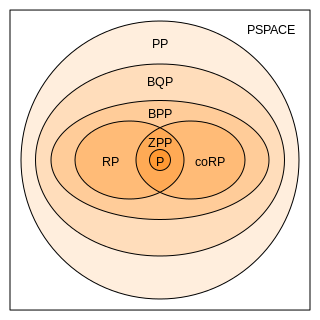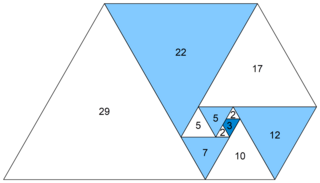
In computational complexity theory, bounded-error quantum polynomial time (BQP) is the class of decision problems solvable by a quantum computer in polynomial time, with an error probability of at most 1/3 for all instances. It is the quantum analogue to the complexity class BPP.
In mathematics, for given real numbers a and b, the logarithm logb a is a number x such that bx = a. Analogously, in any group G, powers bk can be defined for all integers k, and the discrete logarithm logb a is an integer k such that bk = a. In number theory, the more commonly used term is index: we can write x = indra (mod m) (read "the index of a to the base r modulo m") for r x ≡ a (mod m) if r is a primitive root of m and gcd(a,m) = 1.

In probability theory and statistics, the Gumbel distribution is used to model the distribution of the maximum of a number of samples of various distributions.
In computer science, a one-way function is a function that is easy to compute on every input, but hard to invert given the image of a random input. Here, "easy" and "hard" are to be understood in the sense of computational complexity theory, specifically the theory of polynomial time problems. This has nothing to do with whether the function is one-to-one; finding any one input with the desired image is considered a successful inversion.
The Cayley–Purser algorithm was a public-key cryptography algorithm published in early 1999 by 16-year-old Irishwoman Sarah Flannery, based on an unpublished work by Michael Purser, founder of Baltimore Technologies, a Dublin data security company. Flannery named it for mathematician Arthur Cayley. It has since been found to be flawed as a public-key algorithm, but was the subject of considerable media attention.
In mathematics, the Smith normal form is a normal form that can be defined for any matrix with entries in a principal ideal domain (PID). The Smith normal form of a matrix is diagonal, and can be obtained from the original matrix by multiplying on the left and right by invertible square matrices. In particular, the integers are a PID, so one can always calculate the Smith normal form of an integer matrix. The Smith normal form is very useful for working with finitely generated modules over a PID, and in particular for deducing the structure of a quotient of a free module. It is named after the Irish mathematician Henry John Stephen Smith.
Pollard's rho algorithm for logarithms is an algorithm introduced by John Pollard in 1978 to solve the discrete logarithm problem, analogous to Pollard's rho algorithm to solve the integer factorization problem.
In numerical analysis, the Crank–Nicolson method is a finite difference method used for numerically solving the heat equation and similar partial differential equations. It is a second-order method in time. It is implicit in time, can be written as an implicit Runge–Kutta method, and it is numerically stable. The method was developed by John Crank and Phyllis Nicolson in the 1940s.

In group theory, the Pohlig–Hellman algorithm, sometimes credited as the Silver–Pohlig–Hellman algorithm, is a special-purpose algorithm for computing discrete logarithms in a finite abelian group whose order is a smooth integer.
In natural language processing, latent Dirichlet allocation (LDA) is a Bayesian network for modeling automatically extracted topics in textual corpora. The LDA is an example of a Bayesian topic model. In this, observations are collected into documents, and each word's presence is attributable to one of the document's topics. Each document will contain a small number of topics.
The normal-inverse Gaussian distribution is a continuous probability distribution that is defined as the normal variance-mean mixture where the mixing density is the inverse Gaussian distribution. The NIG distribution was noted by Blaesild in 1977 as a subclass of the generalised hyperbolic distribution discovered by Ole Barndorff-Nielsen. In the next year Barndorff-Nielsen published the NIG in another paper. It was introduced in the mathematical finance literature in 1997.
Continuous wavelets of compact support alpha can be built, which are related to the beta distribution. The process is derived from probability distributions using blur derivative. These new wavelets have just one cycle, so they are termed unicycle wavelets. They can be viewed as a soft variety of Haar wavelets whose shape is fine-tuned by two parameters and . Closed-form expressions for beta wavelets and scale functions as well as their spectra are derived. Their importance is due to the Central Limit Theorem by Gnedenko and Kolmogorov applied for compactly supported signals.
In computational number theory and computational algebra, Pollard's kangaroo algorithm is an algorithm for solving the discrete logarithm problem. The algorithm was introduced in 1978 by the number theorist John M. Pollard, in the same paper as his better-known Pollard's rho algorithm for solving the same problem. Although Pollard described the application of his algorithm to the discrete logarithm problem in the multiplicative group of units modulo a prime p, it is in fact a generic discrete logarithm algorithm—it will work in any finite cyclic group.

In mathematics, the structure constants or structure coefficients of an algebra over a field are the coefficients of the basis expansion of the products of basis vectors. Because the product operation in the algebra is bilinear, by linearity knowing the product of basis vectors allows to compute the product of any elements . Therefore, the structure constants can be used to specify the product operation of the algebra. Given the structure constants, the resulting product is obtained by bilinearity and can be uniquely extended to all vectors in the vector space, thus uniquely determining the product for the algebra.
In mathematics the Function Field Sieve is one of the most efficient algorithms to solve the Discrete Logarithm Problem (DLP) in a finite field. It has heuristic subexponential complexity. Leonard Adleman developed it in 1994 and then elaborated it together with M. D. Huang in 1999. Previous work includes the work of D. Coppersmith about the DLP in fields of characteristic two.

In mathematics, Jacobi polynomials are a class of classical orthogonal polynomials. They are orthogonal with respect to the weight on the interval . The Gegenbauer polynomials, and thus also the Legendre, Zernike and Chebyshev polynomials, are special cases of the Jacobi polynomials.

In mathematics, the Perrin numbers are a doubly infinite constant-recursive integer sequence with characteristic equation x3 = x + 1. The Perrin numbers bear the same relationship to the Padovan sequence as the Lucas numbers do to the Fibonacci sequence.
In mathematics, the Kodaira–Spencer map, introduced by Kunihiko Kodaira and Donald C. Spencer, is a map associated to a deformation of a scheme or complex manifold X, taking a tangent space of a point of the deformation space to the first cohomology group of the sheaf of vector fields on X.
The cyclotomic fast Fourier transform is a type of fast Fourier transform algorithm over finite fields. This algorithm first decomposes a DFT into several circular convolutions, and then derives the DFT results from the circular convolution results. When applied to a DFT over , this algorithm has a very low multiplicative complexity. In practice, since there usually exist efficient algorithms for circular convolutions with specific lengths, this algorithm is very efficient.

In computer science, a suffix automaton is an efficient data structure for representing the substring index of a given string which allows the storage, processing, and retrieval of compressed information about all its substrings. The suffix automaton of a string is the smallest directed acyclic graph with a dedicated initial vertex and a set of "final" vertices, such that paths from the initial vertex to final vertices represent the suffixes of the string.



























